-
![[Hippolyte Prosper Olivier LISSAGARAY]. History of the Commune of 1871 / Translated from the French of Lissagaray by Eleanor Marx Aveling. London: Reeved and Turner, 1886. pp.: [i-v] vi-xv [1] 2-500.](https://varshavskycollection.com/wp-content/uploads/2021/02/LIB-1110.2016-d-500x500.jpeg) Hardcover volume, collated in-8o, 21.9 c 14.6 cm, bound in half red morocco over red buckram by Palmer, Hove & Co. (Manchester), ruled in gilt, marbled end-papers, top edge gilt, spine with raised bands, ruled in gilt, gilt lettering; bookplate "Ex libris William John Robertson" with black ink ms dated 1922 to front pastedown. Insert paper clipping “In Memoriam” marked “D.W. 25.1.61.” Graphite ms to t.p.: “[assisted by Karl Marx]”. Pp.: [i-v] vi-xv [xvi blank], [1] 2-500; collation: ffl blank first and last, π8 A-2H8 2I2. Title-page: HISTORY | OF | THE COMMUNE OF 1871. | Translated from the French of | LISSAGARAY, | BY | ELEANOR MARX AVELING. | LONDON: | REEVES AND TURNER, 196 STRAND. | 1886.|| Contributors: Hippolyte Prosper-Olivier Lissagaray (French, 1838 – 1901) – author. Eleanor Marx [Aveling] (British, 1855 – 1898) – translator. William John Robertson (Canadian, 1846 – 1894) – provenance. The Russian translation of the same title: [LIB-1158.2016] Э. Лиссагарэ. История Парижской Коммуны в 1871 г. (Дешевая библиотека, № 274) / Пер. под ред. В. Базарова. — С.-Петербург: Знание, 1906.
Hardcover volume, collated in-8o, 21.9 c 14.6 cm, bound in half red morocco over red buckram by Palmer, Hove & Co. (Manchester), ruled in gilt, marbled end-papers, top edge gilt, spine with raised bands, ruled in gilt, gilt lettering; bookplate "Ex libris William John Robertson" with black ink ms dated 1922 to front pastedown. Insert paper clipping “In Memoriam” marked “D.W. 25.1.61.” Graphite ms to t.p.: “[assisted by Karl Marx]”. Pp.: [i-v] vi-xv [xvi blank], [1] 2-500; collation: ffl blank first and last, π8 A-2H8 2I2. Title-page: HISTORY | OF | THE COMMUNE OF 1871. | Translated from the French of | LISSAGARAY, | BY | ELEANOR MARX AVELING. | LONDON: | REEVES AND TURNER, 196 STRAND. | 1886.|| Contributors: Hippolyte Prosper-Olivier Lissagaray (French, 1838 – 1901) – author. Eleanor Marx [Aveling] (British, 1855 – 1898) – translator. William John Robertson (Canadian, 1846 – 1894) – provenance. The Russian translation of the same title: [LIB-1158.2016] Э. Лиссагарэ. История Парижской Коммуны в 1871 г. (Дешевая библиотека, № 274) / Пер. под ред. В. Базарова. — С.-Петербург: Знание, 1906. -
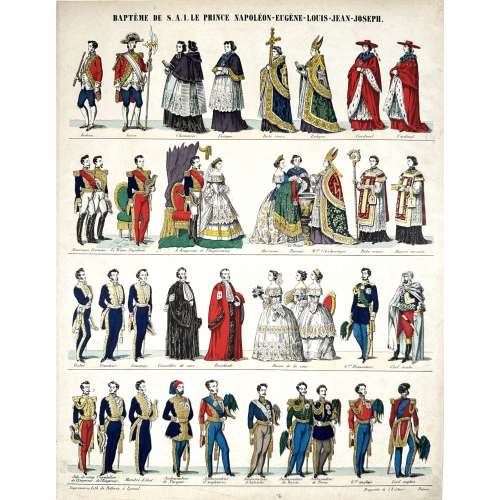 Hand-coloured woodcut on wove paper, 460 x 363 mm; black ink stamp “5054” to reverse. Four tiers with groups of people dressed in uniform, captioned: Bedeau — Suisse — Chanoines — Évêque — Porte croix — Évêque — Cardinal — Cardinal | Généraux français — Le prince Napoléon — L’Empereur et l’Impératrice — Marraine — Le Prince — Parrain | Meur l’Archevêque | Porte crosse Diacre servant | Préfet — Sénateur — Conseiller de cour — Président — Dames de la cour — Gral Piémontais — Chef arabe | Aide-de-camp de l’Empereur — Chambellan de l’Empereur — Ministre d’état — Ambassadeur de Turque | Ambassadeur d’Angleterre — Ambassadeur d’Autriche — Ambassadeur de Russie — Ambassadeur de Prusse — Gral anglaise — Lord anglais || Bottom left: Imprimerie Lith. de Pellerin, à Épinal; right: Propriété de l’Éditeur. — Déposé. Jean Charles Pellerin (French, 1756 – 1836) – printer/publisher.
Hand-coloured woodcut on wove paper, 460 x 363 mm; black ink stamp “5054” to reverse. Four tiers with groups of people dressed in uniform, captioned: Bedeau — Suisse — Chanoines — Évêque — Porte croix — Évêque — Cardinal — Cardinal | Généraux français — Le prince Napoléon — L’Empereur et l’Impératrice — Marraine — Le Prince — Parrain | Meur l’Archevêque | Porte crosse Diacre servant | Préfet — Sénateur — Conseiller de cour — Président — Dames de la cour — Gral Piémontais — Chef arabe | Aide-de-camp de l’Empereur — Chambellan de l’Empereur — Ministre d’état — Ambassadeur de Turque | Ambassadeur d’Angleterre — Ambassadeur d’Autriche — Ambassadeur de Russie — Ambassadeur de Prusse — Gral anglaise — Lord anglais || Bottom left: Imprimerie Lith. de Pellerin, à Épinal; right: Propriété de l’Éditeur. — Déposé. Jean Charles Pellerin (French, 1756 – 1836) – printer/publisher. -
 UTAGAWA TOYOKUNI I (1769–1825) Ichikawa Danjūrō VII (Ebizo V) in a shibaraku costume bursting through a paper screen. Surimono. Colour woodblock print: shikishiban, 8⅛ x 7⅛ in. (20.7 x 18.2 cm) Signed: Toyokuni ga Poem signed: Sakuragawa Jihinari Provenance: Sidney C. Ward
UTAGAWA TOYOKUNI I (1769–1825) Ichikawa Danjūrō VII (Ebizo V) in a shibaraku costume bursting through a paper screen. Surimono. Colour woodblock print: shikishiban, 8⅛ x 7⅛ in. (20.7 x 18.2 cm) Signed: Toyokuni ga Poem signed: Sakuragawa Jihinari Provenance: Sidney C. Ward -
 This print was sold to me with the following description: "Ikkansai EISHO (Fl. early 19th c.). A portrait of the wrestler Kuroyanagi Matsujiro, ring name Kumagatake Inosuke. Eisho was a pupil of Eishi. Published c. 1820s by Uoya Eikichi. Signed Shunsai Eisho ga." As a result of our joint effort with my beloved sister, we have so far found the following: The artis is mentioned in The Hotei Encyclopedia of Japanese Woodblock Prints, 2005, Vol 2; p. 438 under the name of Harukawa Eichō. From this source we learned that the artist was active from about 1818 till 1844, and was a print designer in Kyoto. He was a student first of Harukawa Goshichi and later studied in Edo (Tokyo) with Keisai Eisen, when he assumed the art name 'Eichō'. Other names: Shunsai. The Japanese web page dedicated to Harukawa Eichō provides more details: The artist lived from the 4th year of Tenmei ( 1784 ) to the first year of Kaei ( 1848 ). He was a student of Harukawa Goshichi, Kikukawa Eizan as well as of Keisai Eisen. His popular name was Kamenosuke. He was from Kyoto. He took "gagō" (artistic names) of Eishō when he was a student of Harukawa Goshichi; later, when he became a student of Kikukawa Eizan and Keisai Eisen he took the name of Kikukawa Eichō. The artist was mostly known for his bijinga (beautiful women) prints as well as kanazōshi illustrations. Nothing is said anywhere about his sumo prints, though the reference to another Kyushu sumo wrestler portrait has been found. The sumo wrestler Kuroyanagi Matsujiro is also a somewhat obscure figure: information about his life and career is quite inconsistent. It may so happened that two different persons were combined together. Wikipedia page about Aoi Aso Jinja, a Shinto shrine in Hitoyoshi in Kumamoto prefecture, tells us the following:This information has some inconsistencies already. If our hero was born in 1807 and promoted to ōzeki at the age of 32, it should have been the year 1839, not 1847. I found Kumagatake Isuke at "Sumo Reference" website:
This print was sold to me with the following description: "Ikkansai EISHO (Fl. early 19th c.). A portrait of the wrestler Kuroyanagi Matsujiro, ring name Kumagatake Inosuke. Eisho was a pupil of Eishi. Published c. 1820s by Uoya Eikichi. Signed Shunsai Eisho ga." As a result of our joint effort with my beloved sister, we have so far found the following: The artis is mentioned in The Hotei Encyclopedia of Japanese Woodblock Prints, 2005, Vol 2; p. 438 under the name of Harukawa Eichō. From this source we learned that the artist was active from about 1818 till 1844, and was a print designer in Kyoto. He was a student first of Harukawa Goshichi and later studied in Edo (Tokyo) with Keisai Eisen, when he assumed the art name 'Eichō'. Other names: Shunsai. The Japanese web page dedicated to Harukawa Eichō provides more details: The artist lived from the 4th year of Tenmei ( 1784 ) to the first year of Kaei ( 1848 ). He was a student of Harukawa Goshichi, Kikukawa Eizan as well as of Keisai Eisen. His popular name was Kamenosuke. He was from Kyoto. He took "gagō" (artistic names) of Eishō when he was a student of Harukawa Goshichi; later, when he became a student of Kikukawa Eizan and Keisai Eisen he took the name of Kikukawa Eichō. The artist was mostly known for his bijinga (beautiful women) prints as well as kanazōshi illustrations. Nothing is said anywhere about his sumo prints, though the reference to another Kyushu sumo wrestler portrait has been found. The sumo wrestler Kuroyanagi Matsujiro is also a somewhat obscure figure: information about his life and career is quite inconsistent. It may so happened that two different persons were combined together. Wikipedia page about Aoi Aso Jinja, a Shinto shrine in Hitoyoshi in Kumamoto prefecture, tells us the following:This information has some inconsistencies already. If our hero was born in 1807 and promoted to ōzeki at the age of 32, it should have been the year 1839, not 1847. I found Kumagatake Isuke at "Sumo Reference" website:Kuroki Matsujiro (黒木松次郎) was born in the village of Itsuki in Kuma district, Kumamoto prefecture, island of Kyushu in Bunka era, 4th year (1807). Since from his childhood he was blessed by great physique and tough strength. He had affection for sumo. At the age of 18 he became a sumo student of Kumamoto Shimakawa Ikuhei and took the name of Toyama Hidekichi (遠山日出吉). At the age of 23 (1830), he entered sumo stables in Kyoto, mastered the art of taming of young horses, and his talents improved. At the age of 31 he went to Edo, and became a disciple of the ōzeki Oitekaze Kitaro of Hirado domain in Hizen province, also from Kyushu island. After that, he changed his name and became Kuroyanagi Matsujiro (黒柳松次郎 – as on the print). In 1847 (Bunka era, 4th year) he distinguished himself by advancing to the first grade, and at the age of 32 he was promoted to ozeki level, becoming sekitori. After changing his name to Kuma-ga-take Inosuke (熊ヶ嶽猪之介 / くまがたけいのすけ) he displayed further efforts, and became one of the strongmen that fermented sumo wrestling in Edo. In 1853 (Kaei era, 6th year) he retired and returned to his village, becoming an employee as a strongman of Sagara domain (相良藩), and worked hard as instructor of the sumo training hall to train successors until 1855 (Ansei era, 2nd year) when he passed away at the age of 48. Even today Kuma-ga-take's home exists in Itsukimura (his native village). Also, on those grounds a descendant of Kuma-ga-take runs minshuku (guest house) that bears the name of "The Kuroki Pension (lodging) ", and tourists come to visit from various parts of Japan. In 2015, tenth month, within the borders of Aoi Aso Shrine there was built a gravestone publicly honoring Kuma-ga-take Inosuke, sumo wrestler from Edo / of Edo period.
The real name is the same, the ring name Kuroyanagi Matsujiro is the same, however, the date of birth here is 1815. He fought from 1836 till 1853 - which is quite similar to "At the age of 31 he went to Edo, and became a disciple of the ōzeki Oitekaze Kitaro". Though, in 1836 he might be 29 years old. His bouts are listed from spring 1841 to spring 1848 under the name of Kuroyanagi and from winter 1848 till spring 1853 he listed under the name of Kumagatake Isuke [Inosuke].Highest Rank Maegashira 4 Real Name Kuroki Birth Date 1815 Shusshin Kumamoto-ken, Kuma-gun Death Date March 6, 1855 (40 years) Heya Oitekaze Shikona Kuroyanagi Matsujiro - Kumagatake Isuke Hatsu Dohyo 1836.02 (Sandanme) Intai 1853.02 On another important sumo history website, I found that Kuroyanagi first appeared at ring in the spring of 1823 (he might have been 16 years old then, which does not seem right). Then, in the winter tournament of 1848 Kuroyanagi took the name Kumagatake. At the spring tournament of 1853 Kumagatake (Kuroyanagi) retired. This is quite consistent so far.
Then, I found Oitekaze Kitaro, allegedly the teacher of Kuroyanagi.
Everything look good with an exception of ring names (shikona): Kuroyanagi Matsujiro (1823-1828) - Kuroyanagi Sumiemon (1829-30) - Oitekaze Kitaro (1831-1839). May it be that Sato Matsutaro fought under the name of Kuroyanagi Matsujiro until Kuroki Matsujiro took this name from his master? I don't have another explanation of the enigma. What we know is that we have a portrait of a sumo wrestler called Kuroyanagi Matsujiro from Kyushu, but we don't know whether this was the one from Kumamoto (Kumagatake Inosuke, 1807/1815-1855) or the other from Kanagawa (Oitekaze Kitaro, 1799-1865). Subsequently, we may declare that the artist is Shunsai Eishō, a.k.a.Harukawa Eichō from Eishi school (The Hotei Encyclodepdia, p. 524), we can date the print from 1818 to 1844, and only tell that the wrestler is Kuroyanagi Matsujiro from Kyushu (either Kumagatake Inosuke or Oitekaze Kitaro). The publisher of the print is Moriya Jihei (Marks №353, p. 243-5). That's it.Highest Rank Ozeki Real Name SATO Matsujiro (Matsutaro#) Birth Date 1799 Shusshin Kanagawa-ken, Tsukui-gun Death Date May 4, 1865 (66 years) Heya Oitekaze Shikona Kuroyanagi Matsujiro - Kuroyanagi Sumiemon - Oitekaze Kitaro Hatsu Dohyo 1817.10 (Jonokuchi) Intai 1839.03 -
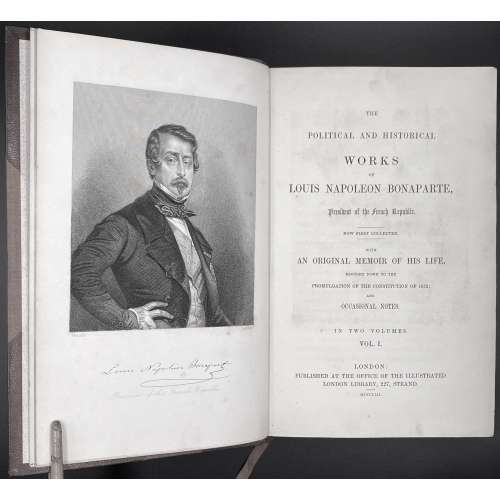 [Bonaparte, Louis Napoleon]. The Political and Historical Works of Louis Napoleon Bonaparte, President of the French Republic, Now First Collected With An Original Memoir of His Life, Brought Down to the Promulgation of the Constitution of 1852; and Occasional Notes, Complete in Two Volumes. London: Illustrated London Library, MDCCCLII [1852]. Collation: Vol. 1: [i-v] vi [vii-viii (blank)] [1] 2-462 [463,464 (blank)]; Vol. 2: [1-3] 4-439 [440]. Size: 22.8 x 14.8 cm (8vo), each. Binding: hardcover; half red morocco and cloth boards, five raised bands, gilt title and decoration, top edge gilt. Frontispiece portrait of Louis Napoleon Bonaparte in Vol. 1. Condition: Very good, rubbing to outer joints, leather corners, faint foxing to endpapers, ownership signature on half-title. Internally bright and unmarked. In binding by Brentano's, New York.
[Bonaparte, Louis Napoleon]. The Political and Historical Works of Louis Napoleon Bonaparte, President of the French Republic, Now First Collected With An Original Memoir of His Life, Brought Down to the Promulgation of the Constitution of 1852; and Occasional Notes, Complete in Two Volumes. London: Illustrated London Library, MDCCCLII [1852]. Collation: Vol. 1: [i-v] vi [vii-viii (blank)] [1] 2-462 [463,464 (blank)]; Vol. 2: [1-3] 4-439 [440]. Size: 22.8 x 14.8 cm (8vo), each. Binding: hardcover; half red morocco and cloth boards, five raised bands, gilt title and decoration, top edge gilt. Frontispiece portrait of Louis Napoleon Bonaparte in Vol. 1. Condition: Very good, rubbing to outer joints, leather corners, faint foxing to endpapers, ownership signature on half-title. Internally bright and unmarked. In binding by Brentano's, New York. -
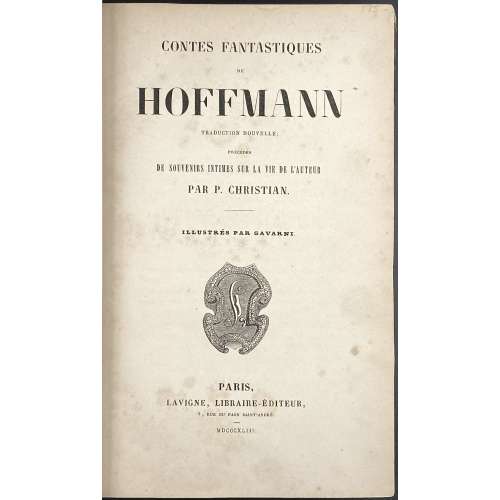 Title: CONTES FANTASTIQUES | DE | HOFFMANN | TRADUCTION NOUVELLE ; PRÉCÉDÉS | DE SOUVENIRS INTIMES SUR LA VIE DE L’AUTEUR | PAR P. CHRISTIAN. | ILLUSTRÉS PAR GAVARNI. | {Publisher’s device} | — PARIS, | LAVIGNE, LIBRAIRE-ÉDITEUR, | 1 RUE DU PAON SAINT-ANDRÉ. | MDCCCXLIII. || Pagination: ffl, [i-vi] –h.t. / colopon, t.p. /blank, dedication /blank, [vii] viii-xix [xx][1,-3] 4-522, bfl, + woodcut illustrations by Brévière et Novionafter Gavarni: 10 full page plates, initials, tail pieces, and in text. Collation: [a]-b4 c2, 1-654 661. Binding: Quarter brown morocco over marbled boards, raised bands with gilt double fillets, gilt arabesque in compartments, title lettering. Catalogue raisonné: L. Carteret (1927), p. 295.
Title: CONTES FANTASTIQUES | DE | HOFFMANN | TRADUCTION NOUVELLE ; PRÉCÉDÉS | DE SOUVENIRS INTIMES SUR LA VIE DE L’AUTEUR | PAR P. CHRISTIAN. | ILLUSTRÉS PAR GAVARNI. | {Publisher’s device} | — PARIS, | LAVIGNE, LIBRAIRE-ÉDITEUR, | 1 RUE DU PAON SAINT-ANDRÉ. | MDCCCXLIII. || Pagination: ffl, [i-vi] –h.t. / colopon, t.p. /blank, dedication /blank, [vii] viii-xix [xx][1,-3] 4-522, bfl, + woodcut illustrations by Brévière et Novionafter Gavarni: 10 full page plates, initials, tail pieces, and in text. Collation: [a]-b4 c2, 1-654 661. Binding: Quarter brown morocco over marbled boards, raised bands with gilt double fillets, gilt arabesque in compartments, title lettering. Catalogue raisonné: L. Carteret (1927), p. 295. -
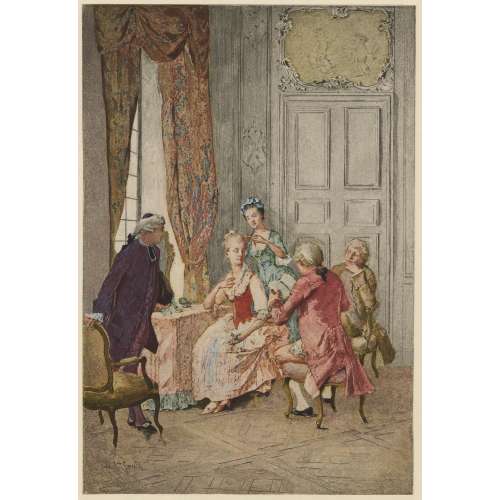
Coloured etching by E. Charreyre (French, fl. 1880 – ?) after a watercolour by Juan Antonio González, (Spanish, 1842 – 1914). A book illustration for 'Son Altesse La Femme' by Octave Uzanne (1851 – 1931), chapter: 'La Caillette' (Le lever d’une petite-maitresse au XVIIIe siècle). Published by Albert Quantin (French, 1850 – 1930) in 1885.
Size: print 17.5 x 12 cm, pasted to leaf 27.7 x 19.5 cm.
-
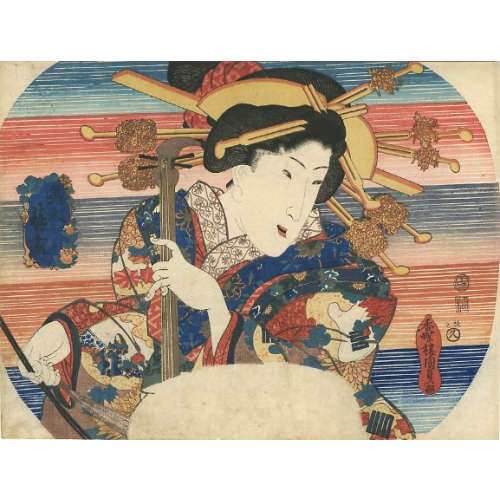 A young woman playing a four-string musical instrument with a bow (kokyū). Series: Assortments of Beauties Accomplishments [美人芸盡] (Bijin gei-zukushi). Utagawa Kunisada [歌川 国貞]; a.k.a. Utagawa Toyokuni III [三代歌川豊国] (Japanese, 1786 – 1865). Signed: Kochoro Kunisada ga [香蝶楼 国貞画] in a red double gourd cartouche. Publisher: Ibaya Kyūbei [伊場屋久兵衛] (Japanese, 1804 – 1851); seal: Hanmoto, Kyū [板元久] (Marks 19-040 | 126e) Date seal: Bunsei 12 (1829). Censors' seal: Kiwame. Size: Fan print (uchiwa-e).
A young woman playing a four-string musical instrument with a bow (kokyū). Series: Assortments of Beauties Accomplishments [美人芸盡] (Bijin gei-zukushi). Utagawa Kunisada [歌川 国貞]; a.k.a. Utagawa Toyokuni III [三代歌川豊国] (Japanese, 1786 – 1865). Signed: Kochoro Kunisada ga [香蝶楼 国貞画] in a red double gourd cartouche. Publisher: Ibaya Kyūbei [伊場屋久兵衛] (Japanese, 1804 – 1851); seal: Hanmoto, Kyū [板元久] (Marks 19-040 | 126e) Date seal: Bunsei 12 (1829). Censors' seal: Kiwame. Size: Fan print (uchiwa-e). -
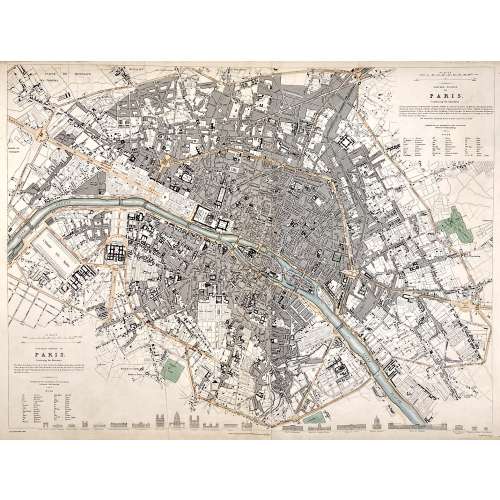 Top right: EASTERN DIVISION OF | PARIS. | Containing the Quartiers | {5 lines in italic} | Published under the Superintendence of the Society for the | Diffusion of Useful Knowledge || Bottom left: WESTERN DIVISION OF | PARIS. | Containing the Quartiers | {4 lines in italic} | Published under the Superintendence of the Society for the | Diffusion of Useful Knowledge || Under the frame: Drawn by W. B. Clarke, Archt. […] London: Published by Chapman and Hall, 186, Strand. April 1st, 1834. [...] Engraved by J. Shury || Dimensions: Sheet: 40.8 x 57 cm; Image: 38.7 x 52.5 cm. Contributors: William Barnard Clarke (British, 1806 – 1865) – artist. John Shury (fl. c. 1814-1844) – engraver. Chapman and Hall (London) – publisher. Society for the Diffusion of Useful Knowledge (SDUK) (British firm, 1826 – 1846).
Top right: EASTERN DIVISION OF | PARIS. | Containing the Quartiers | {5 lines in italic} | Published under the Superintendence of the Society for the | Diffusion of Useful Knowledge || Bottom left: WESTERN DIVISION OF | PARIS. | Containing the Quartiers | {4 lines in italic} | Published under the Superintendence of the Society for the | Diffusion of Useful Knowledge || Under the frame: Drawn by W. B. Clarke, Archt. […] London: Published by Chapman and Hall, 186, Strand. April 1st, 1834. [...] Engraved by J. Shury || Dimensions: Sheet: 40.8 x 57 cm; Image: 38.7 x 52.5 cm. Contributors: William Barnard Clarke (British, 1806 – 1865) – artist. John Shury (fl. c. 1814-1844) – engraver. Chapman and Hall (London) – publisher. Society for the Diffusion of Useful Knowledge (SDUK) (British firm, 1826 – 1846). -
 Superb Edo pictures illustrating dances (Odori keiyô Edo-e no sakae): Interior of an imaginary theatre with a performance of Shibaraku 「踊形容江戸絵栄」. Artist: Utagawa Kunisada [歌川 国貞] a.k.a. Utagawa Toyokuni III [三代歌川豊国] (Japanese, 1786 – 1865). Publisher: Nōshūya Yasubei (Japanese, fl. c. 1851 – 1870). Year: 1858 (Ansei 5), 7th month. Size: Vertical ôban triptych; 36.9 x 75.7 cm. Signed: 一陽斎雛獅豊国筆(年玉印) – Ichiyôsai Hinashi Toyokuni ga (on the left sheet only). Censor's seal: Horse 7 [午七 彫師]. Subject: Shibaraku. Ref.: MFA impression: 11.44263a-c; Robert Schaap. Kunisada (2016), p. 101 [LIB-1212.2017]. Ref.: [LIB-1197.2016] Arendie and Henk Herwig. Heroes of the Kabuki stage: an introduction to Kabuki with retellings of famous plays, illustrated by woodblock prints. — Amsterdam: Hotei Publishing, 2004; p. 38. [LIB-3316.2024] Chris Uhlenbeck, Jim Dwinger, Josephine Smit. The Riddles of Ukiyo-e: Women and Men in Japanese Prints. — Brussels: Ludion, 2023, p. 218-9, № 107.
Superb Edo pictures illustrating dances (Odori keiyô Edo-e no sakae): Interior of an imaginary theatre with a performance of Shibaraku 「踊形容江戸絵栄」. Artist: Utagawa Kunisada [歌川 国貞] a.k.a. Utagawa Toyokuni III [三代歌川豊国] (Japanese, 1786 – 1865). Publisher: Nōshūya Yasubei (Japanese, fl. c. 1851 – 1870). Year: 1858 (Ansei 5), 7th month. Size: Vertical ôban triptych; 36.9 x 75.7 cm. Signed: 一陽斎雛獅豊国筆(年玉印) – Ichiyôsai Hinashi Toyokuni ga (on the left sheet only). Censor's seal: Horse 7 [午七 彫師]. Subject: Shibaraku. Ref.: MFA impression: 11.44263a-c; Robert Schaap. Kunisada (2016), p. 101 [LIB-1212.2017]. Ref.: [LIB-1197.2016] Arendie and Henk Herwig. Heroes of the Kabuki stage: an introduction to Kabuki with retellings of famous plays, illustrated by woodblock prints. — Amsterdam: Hotei Publishing, 2004; p. 38. [LIB-3316.2024] Chris Uhlenbeck, Jim Dwinger, Josephine Smit. The Riddles of Ukiyo-e: Women and Men in Japanese Prints. — Brussels: Ludion, 2023, p. 218-9, № 107. -
 Artist: Utagawa Hiroshige II (二代目 歌川広重] (Japanese, 1826 – 1869). Signed: Hiroshige ga. Publisher: Iseya Sōemon [伊勢屋惣右衛門] (Japanese, c. 1776 – 1862); seal: Hanmoto, Ue [板元 上] (Marks 19-047 | 156d). Combined date seal and kiwame censor seal: Bunkyū 2 (1862) Media: Fan print (uchiwa-e, 団扇絵), 230 x 296 mm.
Artist: Utagawa Hiroshige II (二代目 歌川広重] (Japanese, 1826 – 1869). Signed: Hiroshige ga. Publisher: Iseya Sōemon [伊勢屋惣右衛門] (Japanese, c. 1776 – 1862); seal: Hanmoto, Ue [板元 上] (Marks 19-047 | 156d). Combined date seal and kiwame censor seal: Bunkyū 2 (1862) Media: Fan print (uchiwa-e, 団扇絵), 230 x 296 mm. -
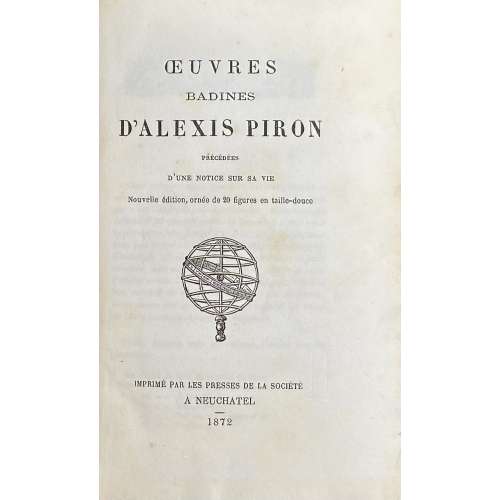 Single volume, 17.1 x 11.2 cm, quarter black sheepskin over faux chagrin, gilt lettering to spine, marbled endpapers, bottom and outer margin untrimmed, pp.: [i-v] vi- xxxvi, [1] 2-218 [2], collated 4to: π2, a-d4, 1-274 282, total 256 pages or 128 leaves, plus 20 engraved plates by Paul Sellier, including frontispiece portrait of Alexis Piron after bust by Caffieri. Vol. 8 of Bibliothèque Libre, Œuvres badines de Piron, printed on February 15, 1872. Text printed on dense wove paper watermarked P or M, plates printed on India wove paper. A reprint of an edition published in 1796 plus illustrations. Title-page: ŒUVRES | BADINES | D’ALEXIS PIRON | PRÉCÉDÉES | D’UNE NOTICE SUR SA VIE | Nouvelle édition, ornée de 20 figures en taille-douce | {vignette} | IMPRIMÉ PAR LES PRESSES DE LA SOCIÉTÉ | A NEUCHATEL | – | 1872 || Limitation: 100 numbered copies, of which this is № 75. Catalogue raisonné: Dutel I: A-788; Pia: 953-6; Kearney 377 (Patrick J. Kearney. A Catalogue of the publications of Jules Gay, Jean-Jules Gay & Gay et Doucé, revised & expanded. — Santa Rosa, CA Scissors & Paste Bibliographies, 2019) Catalogue Poulet-Malassis & ses amis description: № 81. Alexis PIRON. Œuvres badines précédées d’une notice sur sa vie. Nouvelle édition ornée de 20 figures en taille-douce. [ Jules Gay] Imprimé par les presses de la société, à Neufchatel, 1872. In-8, xxxvi, 218 pages et un feuillet d’achevé d’imprimer de table, demi-basane noire, dos à faux nerfs, tête et tranches naturelles. Illustré d’un portrait et de 20 figures par Paul Sellier. Tirage limité à 100 ex. numérotés. De la « Bibliothèque libre ou collection choisie d’ouvrages du genre libre, imprimés ou réimprimés par les soins de la Société des Bibliophiles Cosmopolites et pour les membres de cette société, à cent exemplaires numérotés ». Bibliographie : Pia 1030, Enfer 1274, Lem 3-454, Gay 5-339, PC 353, G* 38, Pey 203, Dutel A-788." Contributors: Alexis Piron (French, 1689 – 1773) – author. Paul Sellier (French, 1842 – 19..?) – artist. Jules Léopold Gay (French, 1807 – 1887) – publisher.
Single volume, 17.1 x 11.2 cm, quarter black sheepskin over faux chagrin, gilt lettering to spine, marbled endpapers, bottom and outer margin untrimmed, pp.: [i-v] vi- xxxvi, [1] 2-218 [2], collated 4to: π2, a-d4, 1-274 282, total 256 pages or 128 leaves, plus 20 engraved plates by Paul Sellier, including frontispiece portrait of Alexis Piron after bust by Caffieri. Vol. 8 of Bibliothèque Libre, Œuvres badines de Piron, printed on February 15, 1872. Text printed on dense wove paper watermarked P or M, plates printed on India wove paper. A reprint of an edition published in 1796 plus illustrations. Title-page: ŒUVRES | BADINES | D’ALEXIS PIRON | PRÉCÉDÉES | D’UNE NOTICE SUR SA VIE | Nouvelle édition, ornée de 20 figures en taille-douce | {vignette} | IMPRIMÉ PAR LES PRESSES DE LA SOCIÉTÉ | A NEUCHATEL | – | 1872 || Limitation: 100 numbered copies, of which this is № 75. Catalogue raisonné: Dutel I: A-788; Pia: 953-6; Kearney 377 (Patrick J. Kearney. A Catalogue of the publications of Jules Gay, Jean-Jules Gay & Gay et Doucé, revised & expanded. — Santa Rosa, CA Scissors & Paste Bibliographies, 2019) Catalogue Poulet-Malassis & ses amis description: № 81. Alexis PIRON. Œuvres badines précédées d’une notice sur sa vie. Nouvelle édition ornée de 20 figures en taille-douce. [ Jules Gay] Imprimé par les presses de la société, à Neufchatel, 1872. In-8, xxxvi, 218 pages et un feuillet d’achevé d’imprimer de table, demi-basane noire, dos à faux nerfs, tête et tranches naturelles. Illustré d’un portrait et de 20 figures par Paul Sellier. Tirage limité à 100 ex. numérotés. De la « Bibliothèque libre ou collection choisie d’ouvrages du genre libre, imprimés ou réimprimés par les soins de la Société des Bibliophiles Cosmopolites et pour les membres de cette société, à cent exemplaires numérotés ». Bibliographie : Pia 1030, Enfer 1274, Lem 3-454, Gay 5-339, PC 353, G* 38, Pey 203, Dutel A-788." Contributors: Alexis Piron (French, 1689 – 1773) – author. Paul Sellier (French, 1842 – 19..?) – artist. Jules Léopold Gay (French, 1807 – 1887) – publisher. -
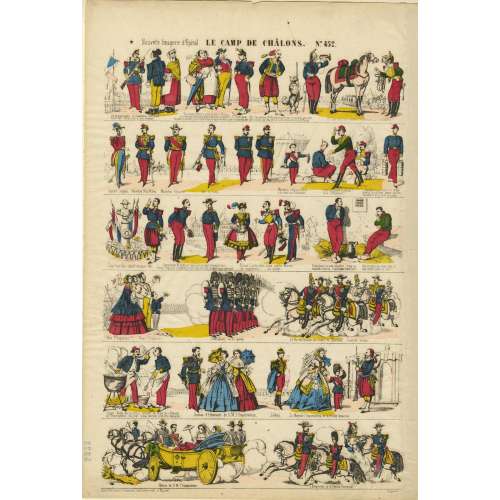 Hand-coloured woodcut on wove paper, 409 x 280 mm; black ink stamp “5323” to reverse; attached to the sheet 487 x 320 mm. Top centre: "LE CAMP DE CHALONS."; left: "Nouvelle Imagerre d'Epinal"; right: № 452. Bottom left: "Imp lith. Pinot & Sagaire, libraires edit. à Épinal"; right: "Déposé". Image: 6-tier cartoon with captions about Napoleon III and his son Prince Imperial (Napoléon Eugène Louis Jean Joseph Bonaparte; 16 March 1856 – 1 June 1879). Le camp de Chalons Pinot & Sagaire (Épinal, 1861 – 1888) – enterprise, publisher/printer. Charles-François Pinot (French, 1817 – 1879) – publisher/printer.
Hand-coloured woodcut on wove paper, 409 x 280 mm; black ink stamp “5323” to reverse; attached to the sheet 487 x 320 mm. Top centre: "LE CAMP DE CHALONS."; left: "Nouvelle Imagerre d'Epinal"; right: № 452. Bottom left: "Imp lith. Pinot & Sagaire, libraires edit. à Épinal"; right: "Déposé". Image: 6-tier cartoon with captions about Napoleon III and his son Prince Imperial (Napoléon Eugène Louis Jean Joseph Bonaparte; 16 March 1856 – 1 June 1879). Le camp de Chalons Pinot & Sagaire (Épinal, 1861 – 1888) – enterprise, publisher/printer. Charles-François Pinot (French, 1817 – 1879) – publisher/printer. -

Макиавелли Николай. Государь (Il Principe) и Рассуждения на первые три книги Тита Ливия. Пер. c итал. Н. Курочкина. Издание "Русской книжной торговли". - СПб.; тип. Тиблена и Ко. (Неклюдова), 1869. - 502 стр.
-
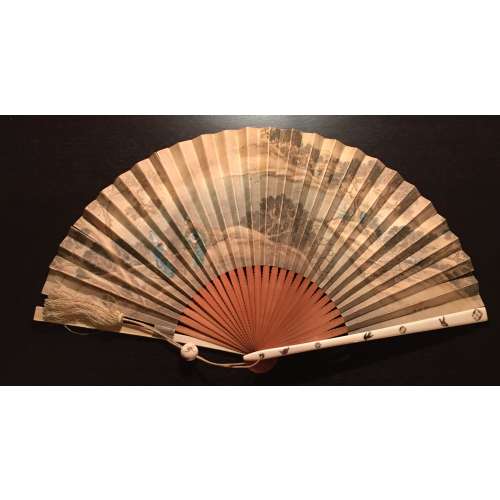 Late 19th-century (1850-1870) Japanese export fan. This fan has a double leaf painted with a different design on either side. Ivory encrusted with gemstones (birds and shippomon motif). Painting by ukiyo-e artist and printmaker Katsushika Isai (1821–1880) represents a riverside landscape with figures; birds and flowers on the reverse. Signed: Isai ga (為斎画) - "Painted by Isai".
Late 19th-century (1850-1870) Japanese export fan. This fan has a double leaf painted with a different design on either side. Ivory encrusted with gemstones (birds and shippomon motif). Painting by ukiyo-e artist and printmaker Katsushika Isai (1821–1880) represents a riverside landscape with figures; birds and flowers on the reverse. Signed: Isai ga (為斎画) - "Painted by Isai". -
 Artist: Utagawa Kuniyoshi [歌川 國芳] (Japanese, 1798 – 1861).
Artist: Utagawa Kuniyoshi [歌川 國芳] (Japanese, 1798 – 1861).Title: Suzume fukube [美人団扇絵] (Sparrow and gourds).
Series: Kacho awase [花鳥合] (Collection of flowers and birds).
Publisher: Aritaya Seiemon [有田屋 清右衛門] (Japanese, fl. c. 1830 – 1862); Seal: Marks 17-011 | 014d.Signed: Ichiyosai Kuniyoshi ga in a red cartouche and sealed with paulownia crest (kiri mon).
Size: Uchiwa-e (untrimmed fan print) 296 x 230 mm.
Double nanushi censor seals: Kinugasa & Watanabe, Kaei 2-3 (1849–50).
Ref.: Kuniyoshi Project. -
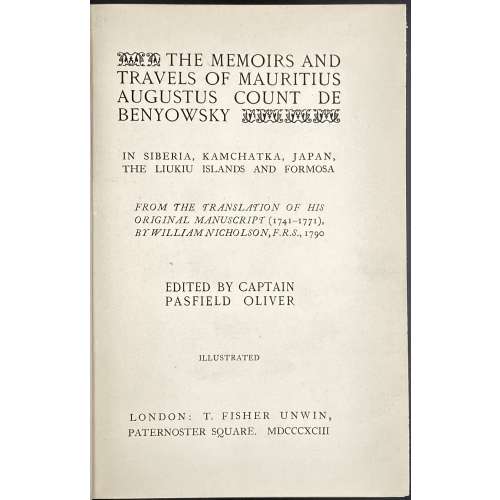 Hardcover volume in 8vo, 21.2 x 15.4 cm, tan cloth with black on gilt background circular publisher’s device "TFU" to front cover, gilt-stamped compartments and burgundy labels with gilt lettering to spine. Ink inscription to fep verso dated Jan 18, 1907. Publisher's device and serial device to h.t. Title-page: ❦❦❦ THE MEMOIRS AND | TRAVELS OF MAURITIUS AUGUSTUS COUNT DE | BENYOWSKY | IN SIBERIA, KAMCHATKA, JAPAN, THE LIUKIU ISLANDS AND FORMOSA | FROM THE TRANSLATION OF HIS | ORIGINAL MANUSCRIPT (1741–1771), | BY WILLIAM NICHOLSON, F.R.S., 1790 | EDITED BY CAPTAIN | PASFIELD OLIVER | ILLUSTRATED | LONDON: T. FISHER UNWIN, | PATERNOSTER SQUARE. MDCCCXCIII ❦❦❦ ||. Collation/Pagination: [1]-258 plus 7 plates, incl. frontispiece and 1 map. [1, 2] – serial h.t. "The Adventure Series" / advert. THE ADVENTURE SERIES. Illustrated. Crown 8vo, 5s. 17 titles, [3, 4] – t.p. / blank, [5] 6-9 contents, [10] blank, [11, 12] illustrations/blank, [13] 14-52 introduction, 53-399, [400] colophon: THE GRESHAM PRESS, | URWIN BROTHERS, | CHILWORTH AND LONDON. Contributors: Publisher: T. Fisher Unwin (London); Thomas Fisher Unwin (British, 1848 – 1935). Author: Maurice Auguste count de Benyowsky [Мориц Август Бенёвский] (Polish-Slovak-Hungarian, 1746 –1786). Editor: Samuel Pasfield Oliver (British, 1838 – 1907). Translator: William Nicholson (British, 1753 – 1815). Originally published in 1790, in London (I have not seen it anywhere) and in Dublin by P. Wogan [etc.], and in 1791 in French, in Paris by Buisson; see LIB-2742.2021. For another copy of the same edition, see LIB-3139.2023. For the 1904 edition, see LIB-2703.2021.
Hardcover volume in 8vo, 21.2 x 15.4 cm, tan cloth with black on gilt background circular publisher’s device "TFU" to front cover, gilt-stamped compartments and burgundy labels with gilt lettering to spine. Ink inscription to fep verso dated Jan 18, 1907. Publisher's device and serial device to h.t. Title-page: ❦❦❦ THE MEMOIRS AND | TRAVELS OF MAURITIUS AUGUSTUS COUNT DE | BENYOWSKY | IN SIBERIA, KAMCHATKA, JAPAN, THE LIUKIU ISLANDS AND FORMOSA | FROM THE TRANSLATION OF HIS | ORIGINAL MANUSCRIPT (1741–1771), | BY WILLIAM NICHOLSON, F.R.S., 1790 | EDITED BY CAPTAIN | PASFIELD OLIVER | ILLUSTRATED | LONDON: T. FISHER UNWIN, | PATERNOSTER SQUARE. MDCCCXCIII ❦❦❦ ||. Collation/Pagination: [1]-258 plus 7 plates, incl. frontispiece and 1 map. [1, 2] – serial h.t. "The Adventure Series" / advert. THE ADVENTURE SERIES. Illustrated. Crown 8vo, 5s. 17 titles, [3, 4] – t.p. / blank, [5] 6-9 contents, [10] blank, [11, 12] illustrations/blank, [13] 14-52 introduction, 53-399, [400] colophon: THE GRESHAM PRESS, | URWIN BROTHERS, | CHILWORTH AND LONDON. Contributors: Publisher: T. Fisher Unwin (London); Thomas Fisher Unwin (British, 1848 – 1935). Author: Maurice Auguste count de Benyowsky [Мориц Август Бенёвский] (Polish-Slovak-Hungarian, 1746 –1786). Editor: Samuel Pasfield Oliver (British, 1838 – 1907). Translator: William Nicholson (British, 1753 – 1815). Originally published in 1790, in London (I have not seen it anywhere) and in Dublin by P. Wogan [etc.], and in 1791 in French, in Paris by Buisson; see LIB-2742.2021. For another copy of the same edition, see LIB-3139.2023. For the 1904 edition, see LIB-2703.2021. -
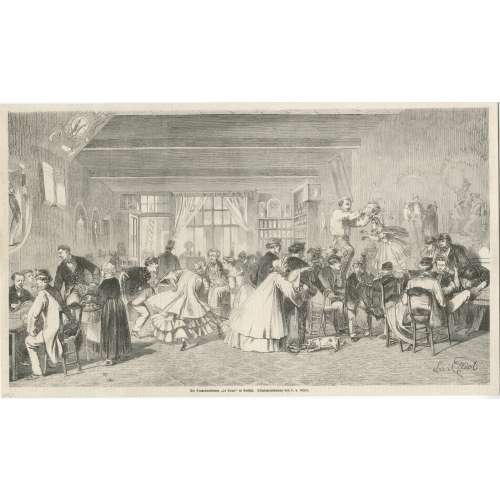
A woodcut illustration after drawing by Leo von Elliot, published at Illustrirte Zeitung, 17 January 1863. English translation: Student bar "The Hole" in Brussels.
The official name of this bar, located at Rue des Sols in Bussels, was "À la vue de l'Université" (In sight of the University). This was the place where the students of the Université libre de Bruxelles (Free University of Brussels), and especially the members of Société, ou Cercle, des Crocodiles (The Crocodile Society, or Circle), gathered in the 1860s.


